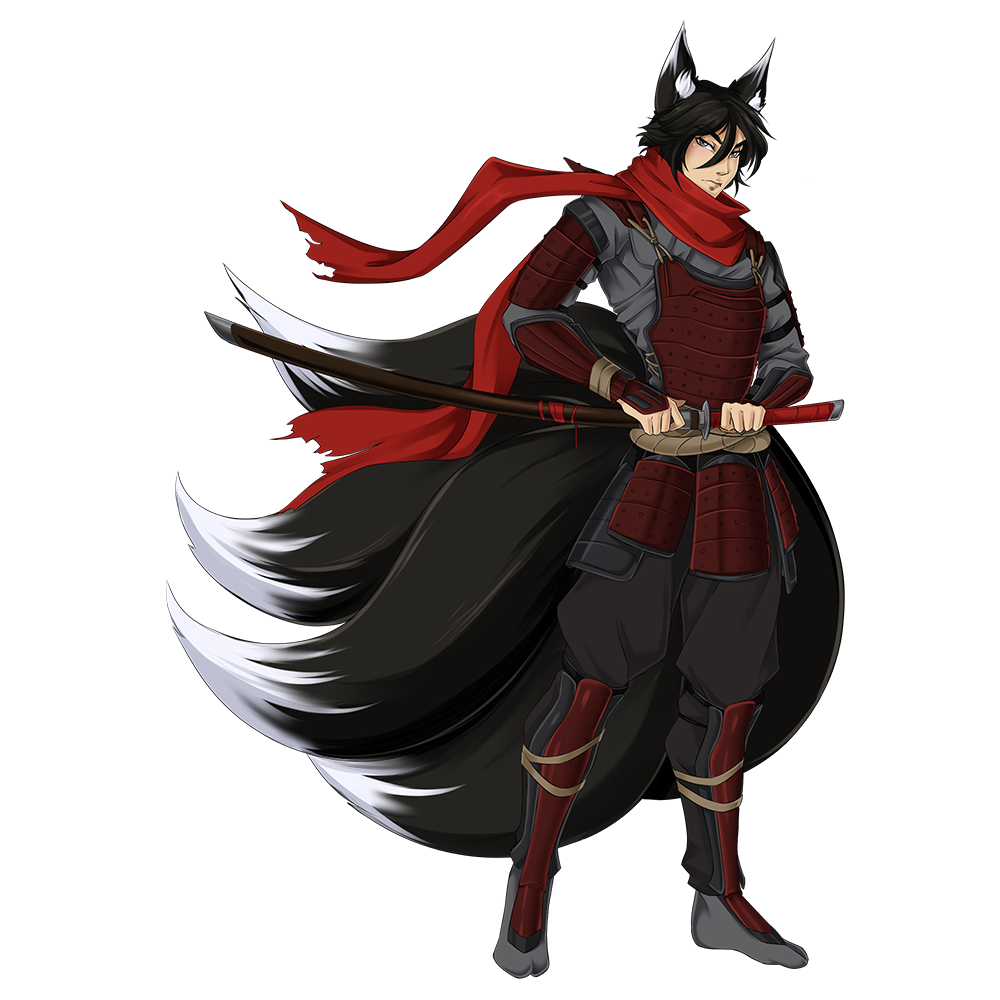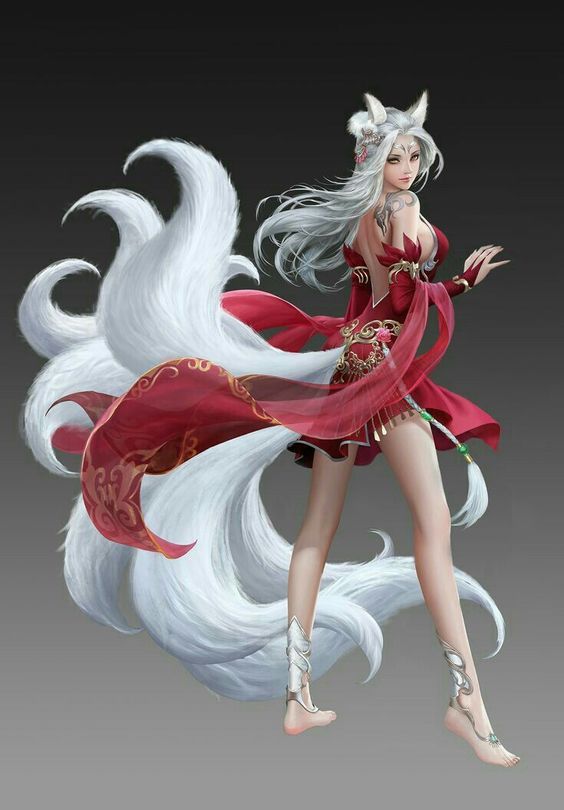Kitsune
Basic Information
Anatomy
The Kitsune's initial appearance was humanoid with more fox-like facial and body features as they quickly evolved due to their celestial creation they began to resemble how they are seen today.
Unlike humans, however, Kitsune have two key features that they do not: Fox Ears, which grant them vastly increased hearing, and their signature tails. Kitsune tails are big and fluffy things that can vary wildly in color, attached to the rear of the Kitsune's body and integrated into their skeleton and musculature to allow them to control them like extensions of their own body. Otherwise, Kitsune's anatomy is relatively similar to that of humanoids.
Genetics and Reproduction
Kitsune reproduces through normal sexual reproduction but Kitsune females can also control their ability to conceive. Female Kitsune carry their children to term in 12-16 months once conceived, and Kitsune have almost an identical capacity to reproduce with other races as humans do thanks to their flexible and similar biology. However, as their lifespans are drastically increased, their sexual drive is even less compared to Elves, who have a minimal amount of sexual drive.
To the Kitsune, reproduction is a sacred and deeply personal thing and something done exclusively with another being as an important and deeply personal step along their life journey with their partner. Many rumors abound that Kitsune who have a sexual experience forced upon them might go so far as to die or become incredibly ill, as such a thing goes so contrary to the influence of Shizen no Otome that it can run harmful to their health.
Growth Rate & Stages
Ecology and Habitats
Kitsune can thrive in any environment they happen to inhabit as they learn to quickly adapt their survival to the place they make their home.
Dietary Needs and Habits
Kitsune are omnivores but prefer to lean toward a more herbivore diet out of respect for the beasts and creatures of nature. They will only resort to eating the flesh of beasts if they have no other options. Kitsune will always over a blessing over any flesh they eat to honor the beast's sacrifice.
Biological Cycle
Kitsune once reaching adulthood tends not to show signs of age beyond the adult stage and because of this, it can be hard to judge the exact age of a Kitsune with an observer's only reference of age being their tails.
The only noticeable measure of the age of a Kitsune is their tails; the longer a Kitsune lives, the more tails they will sprout up to a maximum of 8 tails once they become old enough. Kitsune tails are not just a sign of age and wisdom, but a potentiality of a massive amount of magical and divine power.
After living quite an extended lifetime some Kitsune tire of their current life. Those seeking enlightenment or attempting to try and evolve into the Nine-Tails will go through a ritual of reincarnation returning themselves to the astral to be reborn again to live a new life.
Additional Information
Social Structure
Among the Kiyokans, the Kitsune are treated as nobility and honored when in the presence of any caste of their society. While the Kitsune do not actually have any political power, the nobility stems more from religious belief than political affiliation.
Their religious significance and status has led them to be protected frivolously by the imperial government. Any Kitsune found to have left the borders of Kiyoka are tracked down and aggressively persuaded to return for their own protection.
Facial characteristics
While generally human-looking, a Kitsune does sport a set of fox ears in various shapes, sizes, and colors. Kitsune also have a set of fangs such as those of a fox.
Geographic Origin and Distribution
Kitsune are primarily found within the Kiyokan Empire. It is extremely rare for one to be seen outside of Kiyoka when not on official governmental business.
Average Intelligence
Kitsune are naturally cunning and charismatic and are as intelligent as baseline humans.
Perception and Sensory Capabilities
Kitsune have incredibly sharp senses thanks to not only their Fox Ears, but their overall sharpened sense of smell, sight, and more. Their noses, tongues, eyes, ears, and more are highly sensitive, much more so than humans, and allow them overall enhanced senses but also low-light vision, allowing them to see much further than humans in conditions of low light.
Civilization and Culture
Naming Traditions
A kitsune has a given name and a family name. The given names are usually Kiyon words for nature or natural phenomenon that remind the kitsune’s parents of their child. A kitsune’s family name often reflects some mark of pride for one of the kitsune’s ancestors, such as the descendants of a skilled runner having the family name Swiftpaw.
- Example Female Names: Beku, Chitori, Fuyo, Hanako, Hakara, Kinzami, Kumisa, Mizayuki, Nami, Ozuru, Rikaiyu, Rizumi, Shira, Tayano, Tamoko, Waraba, Zuki
- Example Male Names: Akusai, Baisuo, Daitsugo, Fushiro, Hien, Hiru, Ihan, Isao, Kaimoru, Masaaki, Noshika, Ryu, Satoshi, Shinaro, Takori, Tsumei, Yoji
- Example Family Names: Akiharu, Autumngale, Cherrywind, Chimato, Dancingbreeze, Fusato, Gemmiko, Ichihara, Ironwrought, Joumei, Luckystar, Masei, Sadanako, Sunblaze, Silvertongue, Swiftpaw, Yoshitaka
Relationship Ideals
Kitsune mate for life and tend to only form a permanent bond with another Kitsune. Due to their long lives though they will show interest in other races, however, they do not form the same attachments as they know they far outlive their non-Kitsune partners.
Historical Figures
@Shizen no Otome - the mythical progenitor of the Kitsune.
Common Myths and Legends
In the ancient tales of the Kiyokan's a long ago in distance past the great animals of the world were merely beasts of the land. Hunting, survival, and breeding were all they know while being hunted by the Elves for their skins and meat. The elves were savage in their hunting to point of nearly wiping out the beast in some sections of land they hunted within. The goddess of life saw the beast's sparks of life being extinguished en mass and sent down her Deva in the form of a 9-Tailed Kitsune, Shizen no Otome , spreading her blessing across all of Rinas. Random beasts across the continent began to show more intelligence and cunning and while the elves continued to hunt them it begin to take a toll on the lives of the Elves in greater numbers and ferocity. Those select animals evolve into the Kiyokans of today. Finally, before returning to the heavens Shizen no Otome blessed the foxes with her very essence naming the watchers of their people.
Believed to be immortal, as none have been know or publicly acknowledged to have died outside of sickness or injury.
Kitsune are extremely rare in numbers. It is believed there are as few as a couple thousand in all of Liria. As representatives of the Kiyokan people, they are treated as nobility as well as given noble status. Kitsune's arcane connection also has led to rumors of them being a source of power arcane reagents and because of this, they are rarely known to leave the empire. When one does leave, they are tracked down and brought back for their own protection.
Kitsune comes in many varieties of colors and markings. Their skin color ranges in the same variety seen among most of the humanoid races. The coloring of their tails and ears tends to be two-tone, with a main color and highlight color which adorns a side and tip of their tail and the tips of their ears.
The Ninth Tail
The Ninth Tail, only seen in depictions of the great @Shizen no Otome, is believed among the Kiyokan people to be the ultimate blessing of nobility for the Kitsune. If a Kitsune were to ever appear with nine-tails before the emperor, he would hand down his crown to that Kitsune. It is prophesied that the Nine Tails will bring peace once more to all Kiyokan and the world.
To this date no kitsune has attained the divinity said to be granted by the ninth tail, none are sure how one would obtain such a blessing. There has been speculation and rumors for years on how one might obtain it, but results never came to fruition from attempting them.






Comments